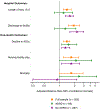Does Alzheimer's Disease and Related Dementias Modify Delirium Severity and Hospital Outcomes?
- PMID: 32255521
- PMCID: PMC7725352
- DOI: 10.1111/jgs.16420
Does Alzheimer's Disease and Related Dementias Modify Delirium Severity and Hospital Outcomes?
Abstract
Objectives: We examined the association between delirium severity and outcomes of delirium among persons with and without Alzheimer's disease and related dementias (ADRD).
Design: Prospective cohort study.
Setting: Academic tertiary medical center.
Participants: A total of 352 medical and surgical patients.
Measurements: Delirium incidence and severity were rated daily using the Confusion Assessment Method (CAM) and CAM-Severity (CAM-S) score during hospitalization. Severe delirium was defined as a CAM-S Short Form score in the highest tertile (3-7 points out of 7). ADRD status was determined by a clinical consensus process. Clinical outcomes included prolonged length of stay (>6 d), discharge to post-acute nursing facility, any decline in activities of daily living (ADLs) at 1 month from prehospital baseline, ongoing nursing facility stay, and mortality.
Results: Patients with ADRD (n = 85 [24%]) had a significantly higher relative risk (RR) for incident delirium (RR = 2.31; 95% confidence interval [CI] = 1.64-3.28) and higher peak CAM-S scores (mean difference = 1.24 points; CI = .83-1.65; P < .001). Among patients with ADRD, severe delirium significantly increased the RR for nursing facility stay (RR = 2.22; CI = 1.05-4.69; P = .04) and increased the RR for mortality (RR = 2.10; CI = .89-4.98; P = .09). Among patients without ADRD, severe delirium was associated with a significantly increased risk for all poor outcomes except mortality including prolonged length of stay in the hospital (RR = 1.47; CI = 1.18-1.82) and discharge to a post-acute nursing facility (RR = 2.17; CI = 1.58-2.98) plus decline in ADLs (RR = 1.30; CI = 1.05-1.60) and nursing facility stay at 1 month (RR = 1.93; CI = 1.31-2.83).
Conclusion: Severe delirium is associated with increased risk for poor clinical outcomes in patients with and without ADRD. In both groups, severe delirium increased risk of nursing home placement. In patients with ADRD, delirium was more severe and associated with a trend toward increased mortality at 1 month. Although the increased risk remains substantial by RR, the study had limited power to examine the rarer outcome of death. J Am Geriatr Soc 68:1722-1730, 2020.
Keywords: Alzheimer's disease and related dementias; clinical outcomes; delirium; delirium severity; dementia.
© 2020 The American Geriatrics Society.
Conflict of interest statement
Figures


References
-
- Burns A, Iliffe S. Dementia. Bmj. February 05 2009;338:b75. - PubMed
-
- Association As. Alzheimer’s Disease Facts and Figures. Alzheimers Dementia. 2017;2017(13):325–373.
-
- Fick DM, Kolanowski AM, Waller JL, Inouye SK. Delirium superimposed on dementia in a community-dwelling managed care population: a 3-year retrospective study of occurrence, costs, and utilization. The journals of gerontology. Series A, Biological sciences and medical sciences. June 2005;60(6):748–753. - PubMed
-
- Fillenbaum G, Heyman A, Peterson B, Pieper C, Weiman AL. Frequency and duration of hospitalization of patients with AD based on Medicare data: CERAD XX. Neurology. February 8 2000;54(3):740–743. - PubMed
Publication types
MeSH terms
Grants and funding
LinkOut - more resources
Full Text Sources
Medical

